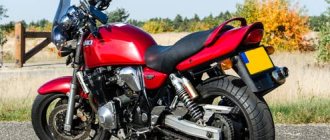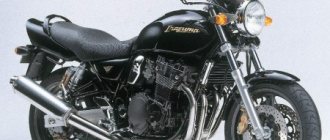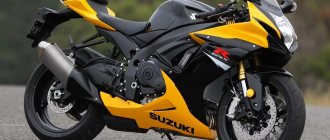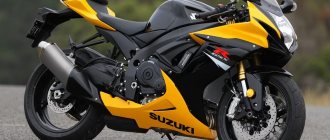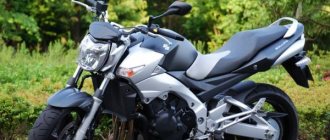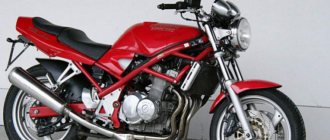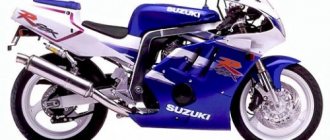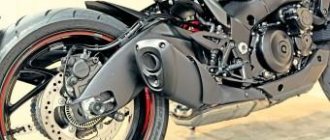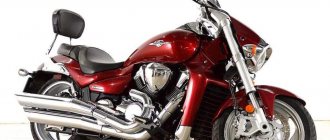Unlike the Bandit 400, which belongs to the naked class, the Suzuki Impulse GSX 400 is a road bike. Its production began in 1994 . The production continued until 2000 .
In 2005, production plans were revised, the model was radically redesigned, after which production began again. The second, final stop occurs two years later and in 2008 the bike goes down in history .
Brief history of the model
1984 – start of production of the model. During this period the motorcycle had 59 hp. power and 38 Nm of torque, with a dry weight of 152 kg.
1985-1987 - the motorcycle receives more advanced engine and carburetor settings, resulting in improved traction at medium and high speeds. The model also receives electrical upgrades and a shorter wheelbase. During this period, the motorcycle uses innovative SATCS technology - the engine is cooled by liquid, oil and air.
1988 - Suzuki GSX-R 400 gets a new frame and appearance. Due to the use of a reinforced chassis and a different exhaust pipe design, the weight of the motorcycle increases slightly. This period is also marked by the use of new carburetors, chrome exhaust and 4-piston Tokico calipers.
1990 - the model receives a new reinforced frame, an inverted fork, new plastic, front 4-piston Nissin calipers, a new swingarm and exhaust system. Thanks to the new exhaust, 60 hp were removed from the engine. at 14500 rpm.
1993 - Under new Japanese legislation, all 400 cc motorcycles must have a power limit of 53 hp, which is why the Suzuki GSX-R 400 was “strangled” (like other models in its class) to meet the new safety standards.
1999 - Suzuki GSX-R 400 officially discontinued.
Photo gallery
Round headlight.
Classic devices.
Left view.
Right view.
Double seat.
Back view.
Specifications
| Model: | Suzuki GSX-R 400 |
| Type: | Sports |
| Year of issue: | 1984 - 1999 |
| Frame: | Aluminum |
| Engine's type: | 4 - cylinder, 4 - stroke |
| Working volume: | 398 cc cm. |
| Bore and stroke: | 56 mm x 40.4 mm |
| Compression ratio: | 12.0:1 |
| Cooling: | Liquid |
| Number of valves per cylinder: | 4,DOHC |
| Fuel supply system: | 4 carburetors |
| Ignition type: | Electronic |
| Maximum power: | 53 hp at 12000 rpm. |
| Maximum torque: | 37 Nm at 9500 rpm. |
| Transmission: | 6-speed |
| Type of drive: | Chain |
| Front tire size: | 120/60-17 |
| Rear tire size: | 160/60-17 |
| Front brake: | two 310 mm discs, 4 piston calipers |
| Rear brake: | one disc 220 mm, 1 - piston caliper |
| Front suspension: | Inverted telescopic fork (all adjustments) |
| Rear suspension: | Monoshock with progression |
| Wheelbase: | 1435 mm |
| Acceleration to 100 km/h: | ~ 5 sec. |
| Maximum speed | 180 km/h |
| Gas tank capacity: | 16 l. |
| Dry weight: | 169 kg. |
Review of the Suzuki GSX 400 Impulse motorcycle
I skated the season on this unit. As always, before purchasing there was a difficult choice of what to take, what to ride... I was looking at motorcycles with an engine capacity of at least 400. I read reviews, impressions, and looked at options. The 600s gradually fell away due to the price tags, so I concentrated on scabies. Of course, the Honda cb400 gets the most praise, and there is quite a wide selection of them. But I was scared off by the stale years and outrageous price tags. For a fairly recent cb400 from 2003-2006, they asked for almost the same amount of money as for their older brother cb600 hornet. Well, for reasonable money (100-130 thousand rubles) they sold older than 98 years, with a mileage of 20-40 thousand km, which is also not very believable.
I accidentally caught my eye impulse. I was interested in the unit. It looks basically the same cb400. Those. The characteristics of all scabies are generally similar, so I tried to find information, reviews from owners, in short, at least something... This is quite difficult. There are not so many of them in Russia, a Japanese spendthrift, for the domestic market (just like everyone else))), but we managed to collect some information.
I came across a 2003 version for 110t.r. The price tag is quite humane, after inspection the condition turned out to be quite tolerable. Next is the actual purchase, registration...
Overall the mot is not bad. It steers like a bicycle and clears traffic jams with a bang. Dynamics in the region of 5 seconds to 100 km.h. When driving with number 2 it drops to about 6 seconds. Like all scabies up to 6t. rpm it drives quite calmly, after which the engine wakes up and spins up to 12-13 rpm (before the cutoff). If you want to play around, then you need to keep the engine at about 7-8 rpm. This will provide sharp throttle response and excellent dynamics. The tank is 16-17 liters with a reserve, without - about 13. Consumption is 5-6 liters, again depending on how you unscrew it. Acceleration is vigorous, but after 140 it fades, I accelerated to a maximum of 170, there was still some reserve, but it was not comfortable, without a windshield. The box is clear, 6 steps. Another plus is the relatively large trunk under the seat.
In terms of maintenance and consumables, everything is also quite simple. Some parts come from bandit, some from cb. There is no need to order consumables, everything is available in motorcycle stores (changed oil filters, air filters, chain, spark plugs, cleaned and synchronized carbs,...), look at the motor's VIN code.
During the season I drove about 9t.km. There were no problems or breakdowns. I was pleased with the motor, a good option for a beginner.
Cheerful, sharp, perfectly controlled.
My first Japanese motorcycle was a 1994 SUZUKI GSX-400 Impulse. Its main competitors: HONDA CB-400 SF, YAMAHA XJR-400, KAWASAKI ZRX-400. I bought a motorcycle completely for free, 3 pieces fell from the sky without any effort. I've been wanting something Japanese for a long time. Oddly enough for a beginner, I wanted a classic (because it’s so fashionable right now - you need sports, the antler darned and the chicks fell over from the sight, and the fact that I don’t know how to drive and have no protection is not for real-life boys), since I did not suffer from a painful awareness of my “uncoolness”. The money for this dream was a little more than 3,000 Baku (it was spring 2003, April).
To be honest, I wanted either the Zephyr-750 or the SV-750, since I had quite a lot of experience in driving the Urals and Izhas. But it was unbearable, and there was no time within 3000 to properly study the market for them. Therefore, I ran into the **** salon and, having slightly aimed at 750, I realized that there was enough money for a “mot”, but for equipment it was a fig, I decided to look at 400. Moreover, the manager, having learned that this would be my first Japanese, definitely recommended 400 Like, you will always have time to kill. Well, I bought this device for 2800 and was happy! I delivered the motorcycle to a friend’s garage on a rainy, cold day. I didn’t have a license or other documents. I repeat again that I am not one of the REAL-patsanoffs and was in no hurry to get on the road without a license. In general, soon all the docks were in order and I started riding the Impulse with a short “long distance” of 400 km. Immediately I felt the assertiveness of the engine (with the discount that this is a 400-hectare, they all have 400-hectare ones) and the no less assertiveness of the oncoming air flow. Without hesitation, at the right moment on the highway I set the speedometer to 180 and realized that my next purchase would be a windshield. The bike pleased me with its convenience, noiselessness and proper operation. Yes, and it was also very beautifully colored, yellow and white, I really liked it. In its class, the motik was the lightest and was declared as the fastest and most dynamic of the classic 400 classics (please do not confuse it with the neoclassics). Of course, it seemed to me the height of perfection, it was pleasant to climb through traffic jams, climb through the forest (clearance allowed, since instead of the original “shocks” that leaked (after flying into a good hole), they were from some kind of chopper, presumably from Viraga-400 ), water cooling prevented the motorcycle from overheating. The suspension, of course, like all 400 classics, was a little soft, but still in moderation. And if you take into account my considerable weight, then it is quite suitable for our roads. In general, this bike was considered by Suzuki itself to be one of the most successful at that time. Everything about it is well done and of high quality. The creators made a mistake with the choice of “carbs”. “Mikuni” suffers from many ailments from time to time, “Keihin” is preferable in this sense. But overall the bike is very good and reliable, I rode about 25,000 km on it in a season and a half. For 400 in such a short time and on our roads the figure is very good. And now the Impulse has been sold to a friend, and during these 25 thousand, no significant changes have occurred in the motorcycle. All you need is competent, careful tuning of the carbs, which is not yet done everywhere and is not cheap. Overall, I’m very pleased with the Motik, I highly recommend it to beginners, don’t let the relative rarity of this model scare you, all consumables are sold without problems in Moscow, but I ordered the air filter in Japan. It was winter and there was nowhere to rush, although if you looked, you could find it in stores, I think.
In general, the main criterion when choosing a motorcycle 400 is whether you like/dislike the appearance, how comfortable/uncomfortable it is to sit, and how “wobbly” a particular instance is. And numerous questions in the forums “which is more reliable, what are the problems with this model” - it’s all nonsense. With such questions you need to approach the “soviet bikes”; this does not apply to the Japanese 400, since all “motos” are tailored according to the same principle and have almost identical characteristics. And 400-acre engines are almost the pinnacle of engine-building perfection, so don’t bother yourself and others with empty markets, grab a competent mechanic and go through showrooms and advertisements, choose the one that’s comfortable to sit on and that pleases the eye.
What can we say about the Suzuki Impulse 400.
In general, I took this model for myself as the first of 400 ok, I previously raced on a cbr250r. To begin with, it seemed nimble and fast to me. After a month of driving...problems began with the mikuni carbs...the model was produced in 1994...however, it came from Japan in 2006 and no one climbed there, and there was no need, in general I cleaned it, changed the spark plugs, made a faucet fuel supply, installed a filter and it still filled the spark plugs, stalled, and did not work smoothly.
After meeting with Glushak, everything was decided; as it turned out, this man is excellent at dealing with these problems and solves them quickly! The next day I was just flying on impulse…….right now it’s in Lipetsk.
